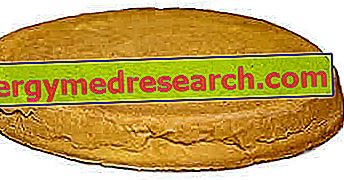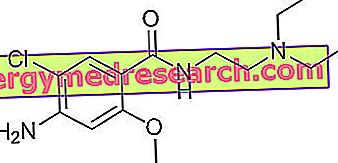Generality
Sponge cake is a basic pastry preparation; it represents the basis for the preparation of soft, stuffed and / or glazed cakes. The sponge cake can be flavored or neutral prepared, further enhancing the composition of the filling or icing.

The ingredients of the classic and neutral (therefore not flavored) sponge cake are: whole eggs, flour and starch, OPTIONALLY baking powder, granulated sugar, butter and flour "as needed" to anti-adhere the mold; the aromas could be: a vanilla bean, grated lemon peel, bitter cocoa. The tools for the preparation of the sponge cake are: planetary or whisk and terrine (to whip the eggs with sugar and powders), spoon, sieve (to avoid incorporating the already clotted powders), mold (with oscillating diameter from 18 to 24cm ) and static or convection oven.
Procedures and recipes for sponge cake
1st variant : break the eggs and separate the egg whites from the yolks; whisk the egg yolks with half of the sugar and whisk the egg whites "a neve"; on the latter, towards the end of the procedure, the remaining sugar will be added. Combine the two compounds with a "bottom-up" movement using a spoon or whisk. Separately, sift the powders WITHOUT chemical yeast and incorporate them with the whisk into the egg and sugar mixture (always from bottom to top); meanwhile preheat the oven to 180 ° C; grease and flour the mold; pour and level the mixture; cook at 180 ° for about 40 '(without opening the oven until "the hypothetical" end of the heat treatment); check the cooking by inserting a toothpick into the sponge cake which, when extracted, MUST be completely DRY; let the sponge cool, then remove it from the mold.
2nd variant : break the eggs into a planetary mixer and whip them together with the sugar; then incorporate the powders and chemical yeast continuing to whisk; preheat the oven to 180 ° C; pour into a mold, buttered and floured, level and cook for at least 30 'at 180 ° C; (without opening the oven to "the hypothetical" end of the heat treatment); check the cooking by inserting a toothpick into the sponge cake which, when extracted, MUST be completely DRY; let the sponge cool, then remove it from the mold.
Video Recipe - Homemade Soft Sponge Cake
Classic sponge cake
X Problems with video playback? Reload from YouTube Go to Video Page Go to Video Recipes Section Watch the video on youtubeWe also report the links for the Cocoa Sponge Cake Video Recipe and for the Vegan Cocoa Sponge Cake with Eggs
Important Factors and Considerations for the Success of the Sponge Cake
The process of sponge cake (as well as the weight of the dough) varies considerably based on the specific recipe. By consulting different sources, the information obtained also seems very different from each other. First of all, as can be seen from the list of ingredients, the use of chemical yeast seems "optional"; this feature is justifiable by the more or less correct procedure for mounting the eggs and incorporating the powders. In fact, if the raw dough has a sufficiently foamy consistency, in cooking there will be no need to exploit the additional gaseous release of chemical yeast; on the contrary, if the sponge cake is NOT mounted "ad hoc", the use of chemical yeast could be fundamental to the success of the recipe. It is also a duty to specify that, in reality, the use of chemical yeast represents a considerable facilitation for professionals working in professional laboratories and pastry shops; in these contexts, where the sponge cake is a habitual and customary mixture, the preparations to be carried out in PARALLEL are really many. This means that instead of:
whip the egg yolks separately with half the sugar and the egg whites with the rest, combine everything gently and then incorporate the sieved powders
it is extremely more comfortable and disengaging:
whip the whole eggs and the sugar in a planetary mixer, then add the powders with the yeast .
The other big difference lies in the quantity and proportions of the flours. The powders used for sponge cake are white wheat flour (type 00) and potato starch. For a mixture of 5 eggs (about 250-265g), the quantity of flour can range from 150 to 250g; it is likely that the greater dose of flour is associated with the rapid assembly of whole eggs and the use of chemical yeast, while the more "unloaded" may make use of the absence of this ingredient as long as the mixture is prepared with the most long and cared for. Furthermore, the proportion between wheat flour and starch is always very variable; also in this case it is likely that the predominance of one over the other varies according to the phase of assembly of the eggs and the use or not of chemical yeast. Wheat flour - which contains gluten and as such (in the presence of GAS) ENSURES leavening of the dough - it is used in larger quantities in the quick preparation characterized by an approximate assembly and the use of chemical yeast. On the contrary, using potato starch up to 50% of the total powders, a remarkable lightness is given to the sponge cake but it NEEDs a more meticulous and accurate procedure in the assembly phase (separated) of the eggs.
NB : White wheat flour type 00, containing gluten, guarantees a certain elasticity to the finished sponge cake (desirable or not desirable based on the destination of the product).
Nutritional characteristics
Sponge cake is a sweet dough made from eggs and flour. It goes without saying that its use in the diet must be uniquely occasional or strictly "grammato", otherwise the overall nutritional balance will be altered due to: excess energy, excess of simple sugars and excess cholesterol.
Sponge cake is a food not recommended in the low-calorie regime due to overweight and obesity; it has a considerable energy density and, taking into consideration that it is always accompanied by farce and icing, its impact on the caloric balance is (like most other sweets) excessively negative. The sponge cake is also impertinent in the dietary pattern for the diabetic, due to the excessive glycemic load and the considerable quantity of simple sugars contained in it. Likewise, sponge cake is not recommended in diet therapy against hypercholesterolemia, not so much for the amount of saturated lipids, but for the real presence of dietary cholesterol (even taking into account the discrete presence of lecithins).
WARNING! In addition to the classic versions of sponge cake, today there are on the net some recipes of sponge cake suitable for feeding in case of metabolic diseases. One of these, present in the archive of "Le Ricette di Alice ", is specifically designed for contextualization in the hypercolesterolemic diet: " Cocoa Sponge Cake with Eggs - Vegan sponge cake against cholesterol ". Thanks to the absence of dietary cholesterol, the discreet presence of soy lecithin and the use of fats rich in essential fatty acids type ω ‰ 6, the systematic use of this sponge cake to replace the traditional one can have a beneficial effect on lipid metabolism in case of hypercholesterolemia.



